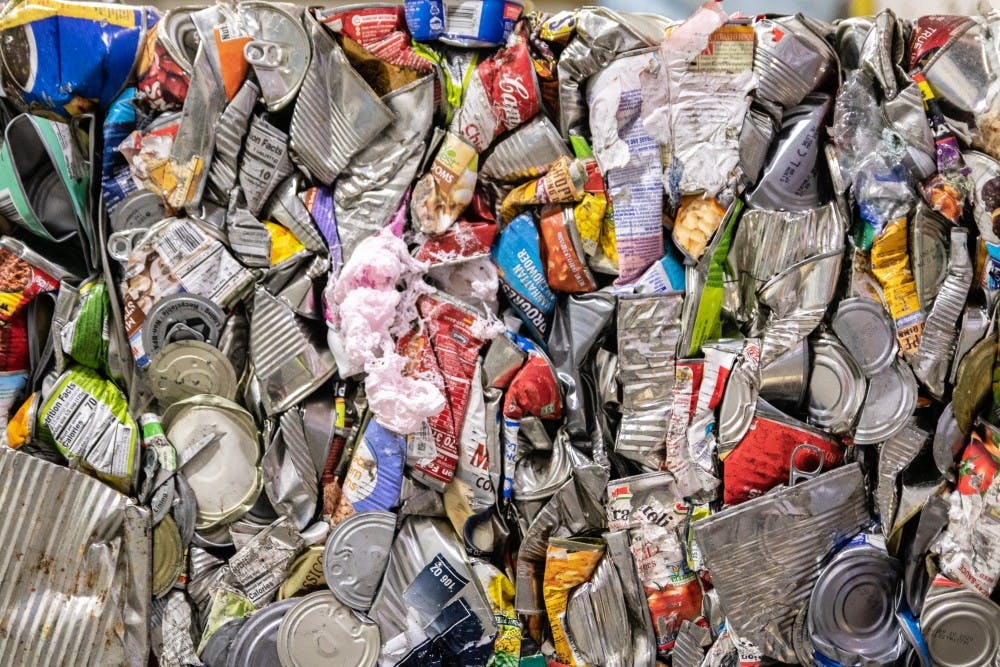Recycling contamination brings risks to impact of on-campus sustainability efforts
Brighton senior Sara McAuliffe, an on-campus environmentalist, admits when it comes to recycling, Central Michigan University's naivety will be its biggest downfall in terms of environmental impact.
Recycling contamination is when incorrect items or materials are put into a recycling system, or when the right items are prepared the wrong way. This can jeopardize initiatives like RecycleMania, the eight week-long recycling initiative requiring campuses to keep track of their recycling rate to be submitted into a competition of nearly 200 colleges which kicked off Feb. 3.
"There is a huge issue with people putting things with food waste or not cleaning out containers into the bins," McAuliffe said. "It basically spoils the whole collection."
McAuliffe is the president of Take Back the Tap (TBTT) at CMU, a registered student organization devoted to eliminating sales of single use plastic water bottles. She also serves as a campus coordinator for Food and Water Watch, a non-governmental organization headquartered in Washington, D.C., specializing in promoting accountability to food and water wellness throughout the nation.
According to Rubicon Global, a cloud-based recycling company headquartered in Georgia, the biggest contaminants include loose shredded-paper, food waste, brightly colored paper and non-rinsed and metal-capped glasses. They said when there are too many contaminants in a load of recycling materials it will likely be sent to landfills despite viable items.
McAuliffe was made more aware of the issue in Fall 2018 during a combined meeting with the Student Environmental Alliance. The group was tasked with dissecting a recycling bin assigned to collecting items made of aluminum, glass and plastic.
"There was spilled coffee all in there from someone carelessly tossing their Starbucks (in)," she said. "I have also talked to (custodial) workers who collect it and they say it's a shame but it happens all the time."
Lakeport senior Chase Delor, the Sustainability Assistant for Facilities Management Administration at CMU, said no sorting is done on campus. Bins are sent directly to the Isabella County Material Recovery Facility (MRF), which is located on the north edge of Mount Pleasant.
"Contamination can be from many different (things), (including) food and plastic bags," said facility director Jake Borton of MRF. "We do everything possible to clean up what is usable. It just depends on what and how much contamination there is."
Borton said the establishment receives contamination everyday, and is responsible for the immediate removal of plastic bags, the biggest and most common contaminators.
He warns recyclers to beware of recycling symbols on items. He said manufactures often place them on their products despite them likely being made of "a mix of different materials and just can't be separated to be recycled."
His facility is unable to accept any materials bound with string or twine, wax-coated cartons or boxes, glossy fax paper, carbon paper, windowed envelopes, window or plate glass or plastics exposed to oil or antifreeze.
Despite contamination being something MRF must take care of every day, contributing to the $1.16 million they paid in 2018 for expenditures, CMU recycling bins only showcase four simple words approving broad recycling categories.
Combined, the different bins authorize magazines, mixed paper, office paper, aluminum, glass and all plastics with no further guidelines.
"I think the best form of retaliation is education; let the students know how to properly recycle and all the ways that they can," said Kalkaska junior Sara Plude, a mechanical engineering student. "Additionally, (CMU can make) sinks accessible close to recycling bins. (There is an) inefficiency of the recycling system here.”









